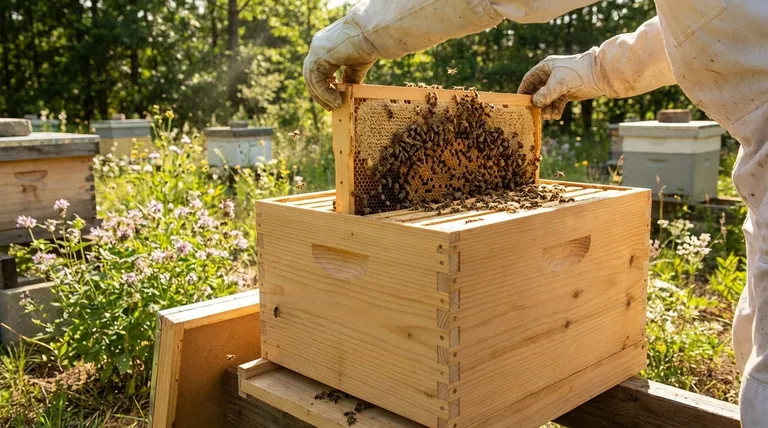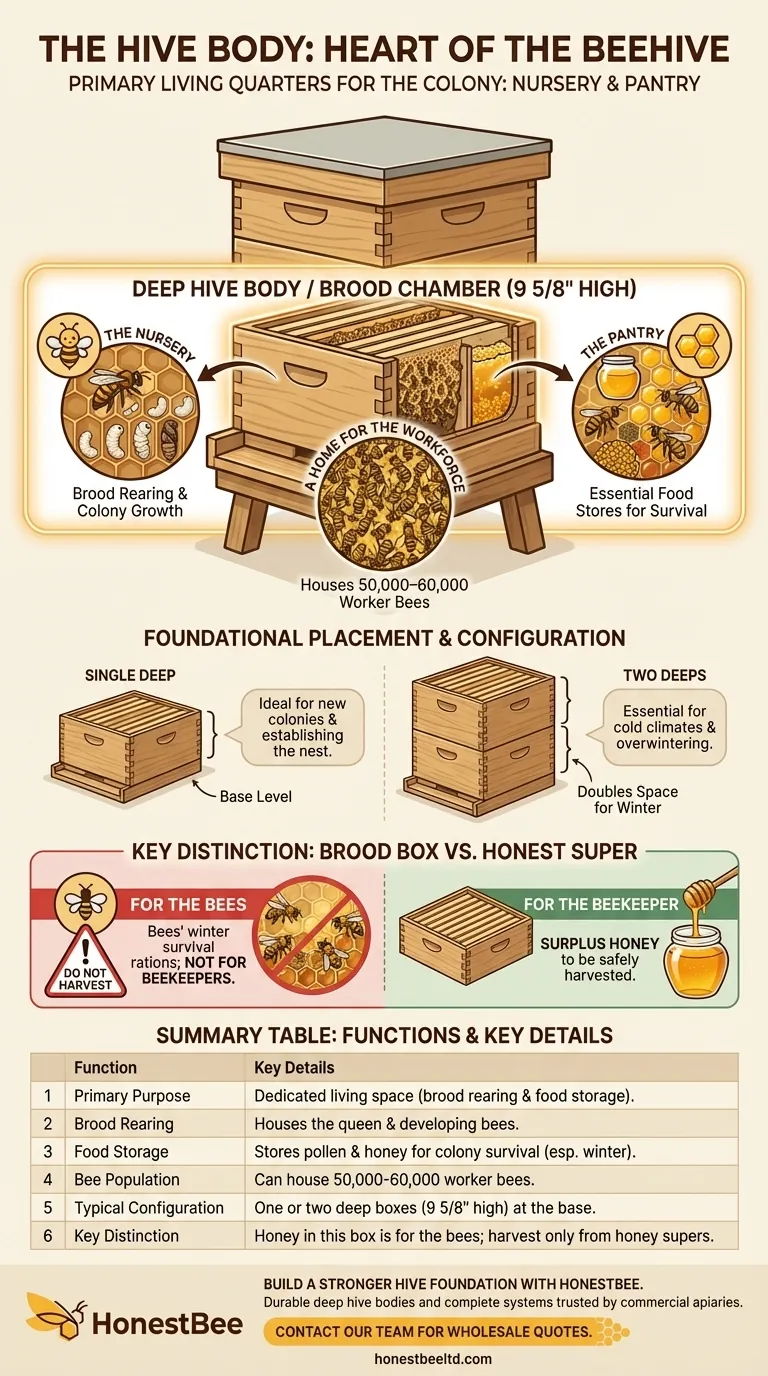At its core, a deep or hive body box is the heart of the beehive. It serves as the primary living quarters for the entire colony, functioning as both a nursery for raising young bees and a pantry for storing the food essential for their survival. This space is exclusively for the bees, not for the beekeeper's honey harvest.
The central purpose of the hive body is to provide a dedicated space for brood rearing and colony food storage. Understanding this distinction—that this box is for the bees' health and survival—is the most critical principle for a new beekeeper to grasp.

The Hive Body: Engine Room of the Colony
The hive body, also known as the brood box or brood chamber, is the foundational component where all colony life and growth originates. It's typically the largest box in the hive, designed to support a massive population.
The Nursery for the Next Generation
The most vital function of the hive body is to house the brood. This is where the queen bee lays her eggs and where worker bees nurture the developing larvae and pupae.
The frames within this box provide the structure for the honeycomb cells where this entire process takes place.
The Colony's Private Pantry
The hive body also serves as the main food storage area for the colony. Worker bees fill the frames with pollen and honey, which are the vital protein and carbohydrate sources needed to feed the brood and sustain the entire colony.
The honey stored in this section is the bees' food reserve, absolutely critical for surviving periods when nectar is scarce, especially during winter.
A Home for the Workforce
A single deep hive body has enough space to house between 50,000 and 60,000 worker bees. This large volume is necessary to support the complex social structure and workforce required for the colony to thrive.
How the Hive Body Fits into the Larger System
A beehive is a modular system, and the hive body's placement and configuration are deliberate. It sits at the bottom of the hive stack, directly on the bottom board.
Foundational Placement
The hive body is the first box placed on the bottom board, making it the ground floor of the colony's home. Everything else, such as honey supers, is built up from this foundation.
Defining Dimensions
The standard deep hive body measures 9 5/8 inches in height, making it taller than the shallower "honey super" boxes that are typically placed above it. This extra depth is required to accommodate both the large brood nest and significant food stores in a single, unified area.
The "One vs. Two Deep" Configuration
In regions with long, cold winters, beekeepers often use two deep hive bodies stacked on top of each other. This doubles the available space, allowing the colony to store enough honey to survive the extended period without incoming nectar.
Understanding the Key Distinction: Brood Box vs. Honey Super
A common point of confusion is the difference between the hive body (brood box) and the boxes used for collecting honey. The purpose of each is entirely different.
The Brood Box is for the Bees
To repeat, the honey stored in the deep hive body is not for the beekeeper. Harvesting from this area would be equivalent to taking the colony's essential winter survival rations, which could lead to starvation and colony collapse.
Honey Supers are for the Beekeeper
Honey supers are the separate, often shallower boxes placed above the brood box. Bees will only begin to store surplus honey in these supers after they have filled their brood chamber with the resources they need. This surplus is what can be safely harvested by the beekeeper without harming the colony.
Structuring Your Hive for Success
How you configure your hive bodies directly impacts the health and productivity of your colony. Your approach should align with your climate and your goals.
- If your primary focus is starting a new colony: Begin with a single deep hive body to allow the colony to establish its brood nest and initial food stores efficiently.
- If your primary focus is overwintering in a cold climate: Use a two-deep hive body configuration to ensure the bees have more than enough honey stored to survive the long winter.
- If your primary focus is maximizing honey harvest: Ensure the brood chamber is strong and thriving before adding honey supers, as a healthy colony is a productive one.
A strong, well-provisioned brood chamber is the foundation upon which a healthy and productive beehive is built.
Summary Table:
| Function | Key Details |
|---|---|
| Primary Purpose | The dedicated living space for the colony (brood rearing & food storage). |
| Brood Rearing | Houses the queen and the development of eggs, larvae, and pupae. |
| Food Storage | Stores pollen and honey reserves for the colony's survival, especially in winter. |
| Bee Population | Can house 50,000-60,000 worker bees. |
| Typical Configuration | One or two deep boxes (9 5/8" high) at the base of the hive. |
| Key Distinction | Honey in this box is for the bees; harvest only from honey supers added above. |
Build a Stronger Hive Foundation with HONESTBEE
A properly configured deep hive body is the cornerstone of a thriving apiary. Equip your operation with the durable, high-quality brood boxes and beekeeping equipment trusted by commercial apiaries and distributors.
HONESTBEE supplies the essential infrastructure your bees need to succeed:
- Durable Deep Hive Bodies: Built to withstand the elements and support heavy brood frames.
- Complete Hive Systems: Modular components designed for optimal colony health and management.
- Wholesale-Focused Operations: Reliable supply and competitive pricing for large-scale beekeeping needs.
Let's discuss how our equipment can support your colony's growth and productivity. Contact our team today to get a quote or learn more about our wholesale offerings.
Visual Guide

Related Products
- Australian Langstroth Beehive Boxes for Beekeeping Wholesales
- 3.5L Plastic Beehive Frame Feeder Deep Frame Water Feeder for In Hive Use
- Langstroth Honey Bee Box Hive Boxes for Different Depths
- HONESTBEE Professional Hive Top Bee Feeder Feeding Solution
- 5 Frame Wooden Nuc Box for Beekeeping
People Also Ask
- Why might a beginner be advised to start with a Langstroth hive? Unlock a Supportive Beekeeping Ecosystem
- How many deep hive bodies should I use? The Standard for a Healthy, Winter-Ready Colony
- What other types of hives are available besides the Flow Hive? Explore Langstroth, Top Bar, and Warre
- What is the best hive for beginners? A Guide to Langstroth, Top Bar, and Flow Hives
- What color should beehives be painted? The Best Choice for Hive Health and Honey Production



















